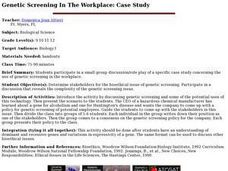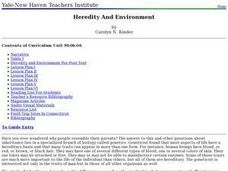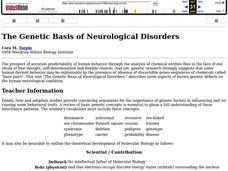US National Library of Medicine
Monster Genetics Lab
Harness young scientists' knowledge of genetics with an engaging science activity. Students start by flipping a coin to determine the genotypes and phenotypes of two parent monsters, before using Punnett squares to...
Virginia Department of Education
Passing Traits to Offspring
What makes each one of us unique? Lead your class in this exciting and educational activity as you uncover traits that show how each individual is different from another. Pupils explore facts about DNA technology and predict the...
Anthropological Association
Race: Teacher Guide: Race
How has the concept of race changed over time? Explore the genetic, cultural, and social aspects of race through a series of impactful activities. Scholars discover how race is influenced by inherited traits, examine census records to...
Towson University
Mystery Disease
How did scientists determine the cause of illness before technology? Science scholars play the role of medical researcher in an engaging guided inquiry activity. Using observations, technical reading, and Punnett squares, learners...
Curated OER
Genetic Screening In The Workplace: Case Study
Students participate in a small group discussion/role play of a specific case study concerning the use of genetic screening in the workplace.
Curated OER
Geneticist for a Day
Students discuss and compose a document discussing the transmission of the Huntington's gene- dominant or recessive, sex linked, etc. Additionally, they ought to consider Dr. Wexler's own odds for contracting the disease.
Curated OER
TE Lesson: What's Dominant?
Students study the number of chromosomes in the body cells, sperm cells, and egg cells of humans. They define allele, and examine the difference between dominant and recessive alleles. They complete an activity with jelly beans that...
Curated OER
Genetics of Parenthood
Students participate in an activity where they flip coins to determine which allele they pass on to the F1 generation and draw the resulting child's face. They identify several inheritance patterns including dominant, recessive,...
Curated OER
Genetics
In this worksheet, students will answer 4 fill in the blank statements about Mendelian inheritance and meiosis. Then students will use Punnett squares to answer three short answer questions. Students will match 8 genetics vocabulary...
US National Library of Medicine
Genetic Traits in Harry Potter
Explore human genetics through the world of Harry Potter. A thorough lesson develops the introductory concepts of genetics using characters of the popular book series. Learners study topics from DNA and chromosomes to Punnett Squares and...
Beyond Benign
Kitten Creation
Your pupils become geneticists as they create cat offspring. The next lesson in a series continues an exploration of genetic makeup as scholars consider parent traits to build their offspring. Using household items, they create kittens...
Science 4 Inquiry
Monster Mash-Up of Genetics
It's alive! Young mad scientists create monsters as they explore the probabilities of genetic traits during a well-structured inquiry lesson. Pairs travel from station to station, rolling the dice and adding traits to their creations as...
Serendip
Genetics Review Jeopardy Game
Why not add a little excitement to review day? Play genetic Jeopardy to quiz your classes before they take the assessment. The resource provides a game board in PowerPoint with questions related to meiosis and prediction of traits.
Curated OER
From Genomes of Species
Pupils investigate genomic research being done and its potential for understanding, treating, and possibly curing human genetic conditions. The potential of proteomic research as a companion to the work being done with genomics is...
Curated OER
Here's Looking at You
Students assess some common inherited traits which are easily observable and note their phenotype for the trait. Students compare their phenotypes to those of their parents and attempt to describe the pattern and manor of inheritance.
Curated OER
Heredity And Environment
Students complete a pre-test on the relationship between heredity and the environment. As a class, they write down descriptions of themselves and identify which traits can be changed and not changed. In groups, they determine which...
Curated OER
Toothpick Fish
Students experiment with genes and environment for a population of "Toothpick Fish."
Curated OER
The Genetic Basis of Neurological Disorders
Students explore neurological disorders. They examine the presence and absence of discernible genes. Students describe neruological diseases and draw faces of affected persons. They play a human neurology disorders learning game.
Curated OER
A Look Into the Past
Students practice looking at their genetics to inquire about their past. In groups, they determine their recessive and dominant genes and plot their height on a graph. They compare and contrast the processes of meiosis and mitosis. ...
Curated OER
How Does a Pedigree Help Us to Trace a Trait That is Inherited?
Learners analyze genetic patterns. In this pedigree lesson, students determine dominant or recessive inheritance. They construct a human pedigree from genetic information.
Curated OER
Traits
Sixth graders consider heredity. In this science lesson plan, 6th graders gain an understanding of certain physical traits are inherited from their parents through the genes.
Curated OER
Genetics: Who are you?
Study, manipulate, and research genetic traits. Discuss how genetic traits are passed from one generation to another. Classmates explore how they look like their parents and debate whether or not they can do anything about it? They...
Curated OER
Genetics Crossword
For this biology worksheet, students complete a crossword puzzle with 38 questions on genetics. They identify the different parts and functions of a flower.
Other popular searches
- Dominant and Recessive Genes
- Dominate and Recessive Genes
- Dominant Recessive Genes
- Define Recessive Genes
- Dominant/recessive Genes
- Recessive Genes Eyes
- Dominant & Recessive Genes
- Dominant Recessive Genes
- Dominant vs Recessive Genes
- Dominant Nd Recessive Genes

























